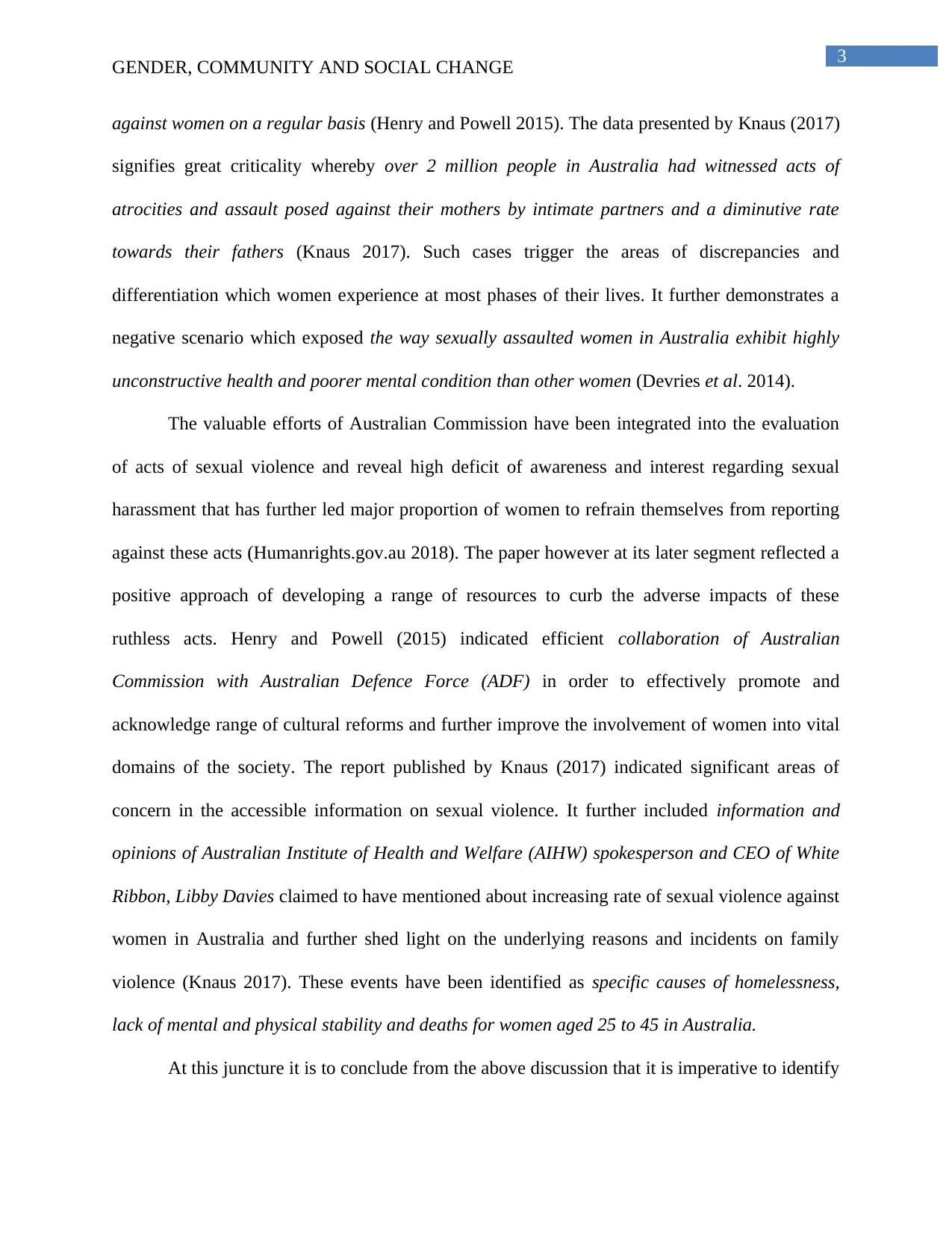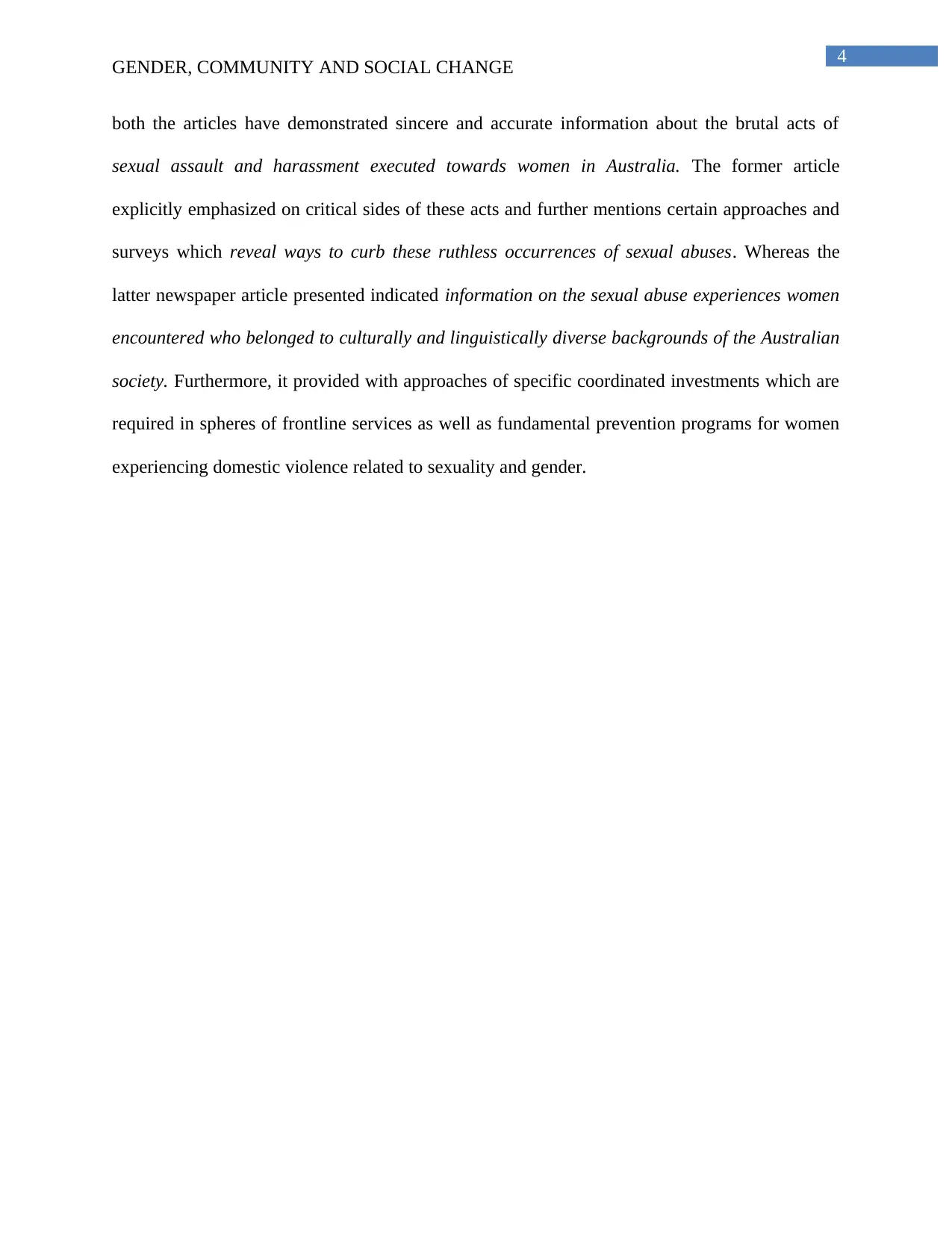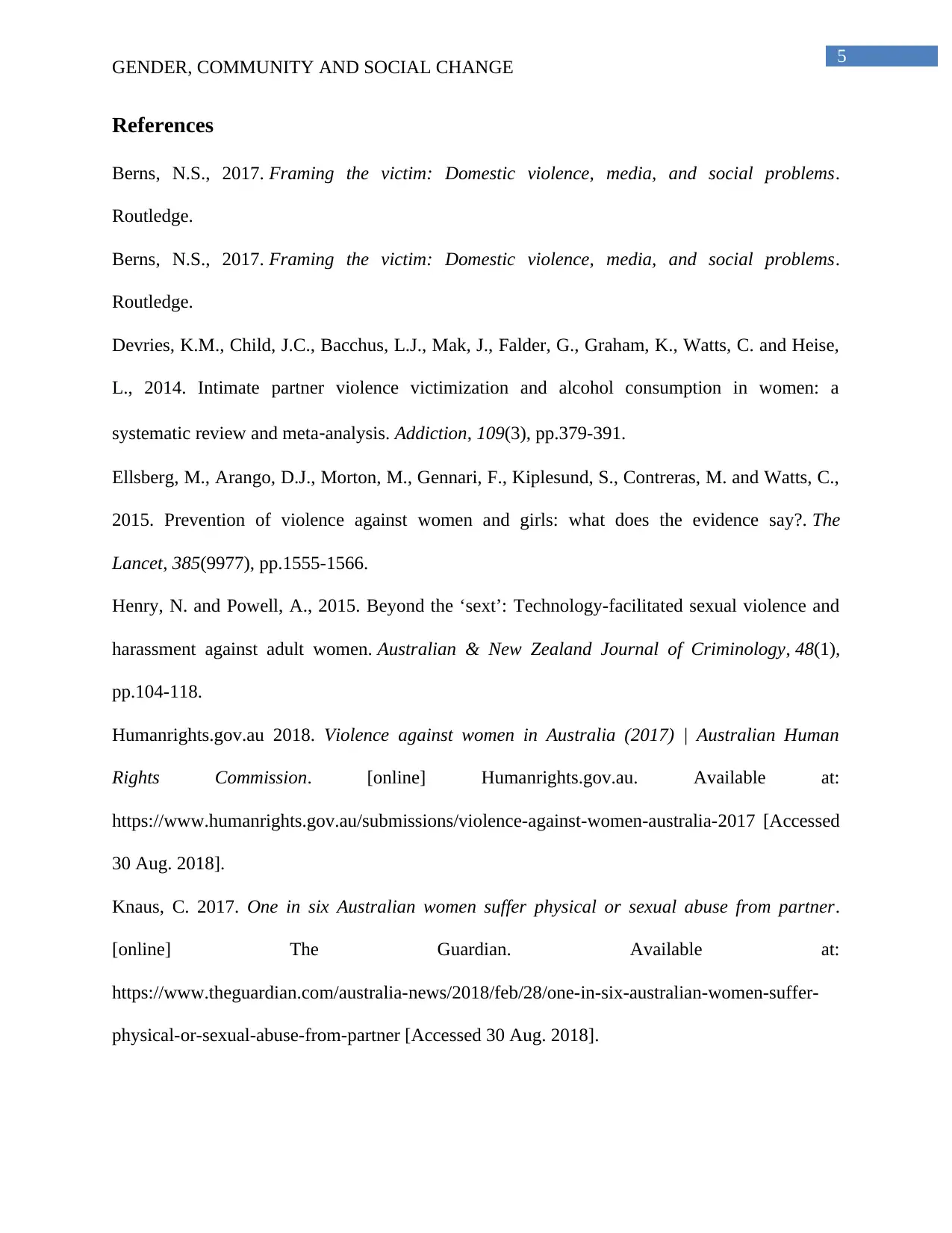Gender, Community, and Social Change: Domestic Violence Analysis
VerifiedAdded on 2023/06/07
|6
|1458
|337
Essay
AI Summary
This essay examines the issue of gender-based violence and domestic violence in Australia, drawing on information from the Australian Human Rights Commission website and a newspaper article published in The Guardian. The essay highlights the alarming rates of intimate partner violence, sexual harassment, and the disproportionate impact on Indigenous women and women with disabilities. It analyzes the underlying causes and consequences of these issues, including the lack of awareness and reporting. The paper further reflects on the efforts of the Australian Commission and the need for comprehensive prevention programs and cultural reforms. The analysis reveals the critical need for coordinated investments in frontline services and prevention programs to address domestic violence related to sexuality and gender in Australia.

Running head: GENDER, COMMUNITY AND SOCIAL CHANGE
GENDER, COMMUNITY AND SOCIAL CHANGE
Name of the Student:
Name of the University:
Author note:
GENDER, COMMUNITY AND SOCIAL CHANGE
Name of the Student:
Name of the University:
Author note:
Paraphrase This Document
Need a fresh take? Get an instant paraphrase of this document with our AI Paraphraser

1
GENDER, COMMUNITY AND SOCIAL CHANGE
Gender-based violence has been considered as any detrimental act purposed against
individuals or groups of individuals on the basis of gender (Devries et al. 2014). These acts may
involve sexual violence, domestic assault, trafficking, imposed early marriage or other forms of
harmful practices (Henry and Powell 2015). Emphasizing on sexual and gender-based violence
in post-conflict contexts is regarded to be immensely crucial for promoting responsibility,
liability and attaining sustainable peace (Ellsberg et al. 2015). The following paper will evaluate
the information provided on the website of Australian Human Rights Commission and on
newspaper article published on The Guardian based on issue of domestic violence related to
gender and sexuality and further comprehend the underlying conjectures provided by these
information.
The website of Australian Human Rights Commission explicitly measures the genuine
context of assault and violence against women as majority of events of domestic violence and
hostility tend to be disregarded and unnoticed by media (Humanrights.gov.au 2018). The article
purposed for the Commission sheds light on the alarming rate of domestic violence posed against
women in Australia. It has been observed that intimate partner aggression or violent behaviour
has been recognized as one of the universal forms of atrocity executed against women whereby
around 2% of women have reported regarding acts of violence by either present or former
partners in past one year (Humanrights.gov.au 2018). However, information associated to sexual
violence published The Guardian newspaper mentions the way one in every six women in
Australia have been facing critical forms of violence and abuse current or previous associate
(Knaus 2017). The article reflects on the research conducted by the Australian Institute of Health
and Welfare which highlights criticalities of the extent of physical as well as sexual violence
towards Australian women.
GENDER, COMMUNITY AND SOCIAL CHANGE
Gender-based violence has been considered as any detrimental act purposed against
individuals or groups of individuals on the basis of gender (Devries et al. 2014). These acts may
involve sexual violence, domestic assault, trafficking, imposed early marriage or other forms of
harmful practices (Henry and Powell 2015). Emphasizing on sexual and gender-based violence
in post-conflict contexts is regarded to be immensely crucial for promoting responsibility,
liability and attaining sustainable peace (Ellsberg et al. 2015). The following paper will evaluate
the information provided on the website of Australian Human Rights Commission and on
newspaper article published on The Guardian based on issue of domestic violence related to
gender and sexuality and further comprehend the underlying conjectures provided by these
information.
The website of Australian Human Rights Commission explicitly measures the genuine
context of assault and violence against women as majority of events of domestic violence and
hostility tend to be disregarded and unnoticed by media (Humanrights.gov.au 2018). The article
purposed for the Commission sheds light on the alarming rate of domestic violence posed against
women in Australia. It has been observed that intimate partner aggression or violent behaviour
has been recognized as one of the universal forms of atrocity executed against women whereby
around 2% of women have reported regarding acts of violence by either present or former
partners in past one year (Humanrights.gov.au 2018). However, information associated to sexual
violence published The Guardian newspaper mentions the way one in every six women in
Australia have been facing critical forms of violence and abuse current or previous associate
(Knaus 2017). The article reflects on the research conducted by the Australian Institute of Health
and Welfare which highlights criticalities of the extent of physical as well as sexual violence
towards Australian women.

2
GENDER, COMMUNITY AND SOCIAL CHANGE
Furthermore, the article on Australian Human Rights Commission website highlights acts
of sexual harassment occurring specifically at workplaces continue to sustain as one of the
critical issues in Australia (Humanrights.gov.au 2018). Several investigations on sexual
aggravation conducted by the Australian Human Rights Commission reveal that women in
particular young woman tend to encounter greater degree of violence, assault and harassment
through social media sites (Berns 2017). Such forms of violence further involve the high rate of
dissemination of confidential data and images of women without any consent or their awareness
(Devries et al. 2014). However, Berns (2017) has observed that women who attempt to advocate
against such crimes tend to be highly exposed towards greater level of threats and atrocities that
typically incorporates both family as well as domestic assault. Knaus (2017) enquired one of the
chief executives of White Ribbon who signified these elevating rates of occurrences as highly
devastating and an innate phenomenon which has been posing critical threats to the Australian
society. It has further been noted that the increasing degree of atrocities and disrespect towards
women is insidious and requires national value and prominence to successfully prevent women
from these acts (Ellsberg et al. 2015).
The issues have been represented in a highly comprehensive manner which further
exposes the underlying reasons to which women in Australia are experiencing such ruthless acts.
Several reports have exposed that women primarily belonging to Indigenous Communities tend
to experience higher degree of physical atrocity at around 3.1 times more in relation to Non-
Indigenous women (Humanrights.gov.au 2018). Data obtained from other resources have further
been analysed which comprehensively mentions the abuse women with disabilities tend to face
and are typically being subjected to such merciless acts for a long period. On the other hand, the
newspaper article presented detailed information of an approximate of 50 acts of sexual violence
GENDER, COMMUNITY AND SOCIAL CHANGE
Furthermore, the article on Australian Human Rights Commission website highlights acts
of sexual harassment occurring specifically at workplaces continue to sustain as one of the
critical issues in Australia (Humanrights.gov.au 2018). Several investigations on sexual
aggravation conducted by the Australian Human Rights Commission reveal that women in
particular young woman tend to encounter greater degree of violence, assault and harassment
through social media sites (Berns 2017). Such forms of violence further involve the high rate of
dissemination of confidential data and images of women without any consent or their awareness
(Devries et al. 2014). However, Berns (2017) has observed that women who attempt to advocate
against such crimes tend to be highly exposed towards greater level of threats and atrocities that
typically incorporates both family as well as domestic assault. Knaus (2017) enquired one of the
chief executives of White Ribbon who signified these elevating rates of occurrences as highly
devastating and an innate phenomenon which has been posing critical threats to the Australian
society. It has further been noted that the increasing degree of atrocities and disrespect towards
women is insidious and requires national value and prominence to successfully prevent women
from these acts (Ellsberg et al. 2015).
The issues have been represented in a highly comprehensive manner which further
exposes the underlying reasons to which women in Australia are experiencing such ruthless acts.
Several reports have exposed that women primarily belonging to Indigenous Communities tend
to experience higher degree of physical atrocity at around 3.1 times more in relation to Non-
Indigenous women (Humanrights.gov.au 2018). Data obtained from other resources have further
been analysed which comprehensively mentions the abuse women with disabilities tend to face
and are typically being subjected to such merciless acts for a long period. On the other hand, the
newspaper article presented detailed information of an approximate of 50 acts of sexual violence
⊘ This is a preview!⊘
Do you want full access?
Subscribe today to unlock all pages.

Trusted by 1+ million students worldwide

3
GENDER, COMMUNITY AND SOCIAL CHANGE
against women on a regular basis (Henry and Powell 2015). The data presented by Knaus (2017)
signifies great criticality whereby over 2 million people in Australia had witnessed acts of
atrocities and assault posed against their mothers by intimate partners and a diminutive rate
towards their fathers (Knaus 2017). Such cases trigger the areas of discrepancies and
differentiation which women experience at most phases of their lives. It further demonstrates a
negative scenario which exposed the way sexually assaulted women in Australia exhibit highly
unconstructive health and poorer mental condition than other women (Devries et al. 2014).
The valuable efforts of Australian Commission have been integrated into the evaluation
of acts of sexual violence and reveal high deficit of awareness and interest regarding sexual
harassment that has further led major proportion of women to refrain themselves from reporting
against these acts (Humanrights.gov.au 2018). The paper however at its later segment reflected a
positive approach of developing a range of resources to curb the adverse impacts of these
ruthless acts. Henry and Powell (2015) indicated efficient collaboration of Australian
Commission with Australian Defence Force (ADF) in order to effectively promote and
acknowledge range of cultural reforms and further improve the involvement of women into vital
domains of the society. The report published by Knaus (2017) indicated significant areas of
concern in the accessible information on sexual violence. It further included information and
opinions of Australian Institute of Health and Welfare (AIHW) spokesperson and CEO of White
Ribbon, Libby Davies claimed to have mentioned about increasing rate of sexual violence against
women in Australia and further shed light on the underlying reasons and incidents on family
violence (Knaus 2017). These events have been identified as specific causes of homelessness,
lack of mental and physical stability and deaths for women aged 25 to 45 in Australia.
At this juncture it is to conclude from the above discussion that it is imperative to identify
GENDER, COMMUNITY AND SOCIAL CHANGE
against women on a regular basis (Henry and Powell 2015). The data presented by Knaus (2017)
signifies great criticality whereby over 2 million people in Australia had witnessed acts of
atrocities and assault posed against their mothers by intimate partners and a diminutive rate
towards their fathers (Knaus 2017). Such cases trigger the areas of discrepancies and
differentiation which women experience at most phases of their lives. It further demonstrates a
negative scenario which exposed the way sexually assaulted women in Australia exhibit highly
unconstructive health and poorer mental condition than other women (Devries et al. 2014).
The valuable efforts of Australian Commission have been integrated into the evaluation
of acts of sexual violence and reveal high deficit of awareness and interest regarding sexual
harassment that has further led major proportion of women to refrain themselves from reporting
against these acts (Humanrights.gov.au 2018). The paper however at its later segment reflected a
positive approach of developing a range of resources to curb the adverse impacts of these
ruthless acts. Henry and Powell (2015) indicated efficient collaboration of Australian
Commission with Australian Defence Force (ADF) in order to effectively promote and
acknowledge range of cultural reforms and further improve the involvement of women into vital
domains of the society. The report published by Knaus (2017) indicated significant areas of
concern in the accessible information on sexual violence. It further included information and
opinions of Australian Institute of Health and Welfare (AIHW) spokesperson and CEO of White
Ribbon, Libby Davies claimed to have mentioned about increasing rate of sexual violence against
women in Australia and further shed light on the underlying reasons and incidents on family
violence (Knaus 2017). These events have been identified as specific causes of homelessness,
lack of mental and physical stability and deaths for women aged 25 to 45 in Australia.
At this juncture it is to conclude from the above discussion that it is imperative to identify
Paraphrase This Document
Need a fresh take? Get an instant paraphrase of this document with our AI Paraphraser

4
GENDER, COMMUNITY AND SOCIAL CHANGE
both the articles have demonstrated sincere and accurate information about the brutal acts of
sexual assault and harassment executed towards women in Australia. The former article
explicitly emphasized on critical sides of these acts and further mentions certain approaches and
surveys which reveal ways to curb these ruthless occurrences of sexual abuses. Whereas the
latter newspaper article presented indicated information on the sexual abuse experiences women
encountered who belonged to culturally and linguistically diverse backgrounds of the Australian
society. Furthermore, it provided with approaches of specific coordinated investments which are
required in spheres of frontline services as well as fundamental prevention programs for women
experiencing domestic violence related to sexuality and gender.
GENDER, COMMUNITY AND SOCIAL CHANGE
both the articles have demonstrated sincere and accurate information about the brutal acts of
sexual assault and harassment executed towards women in Australia. The former article
explicitly emphasized on critical sides of these acts and further mentions certain approaches and
surveys which reveal ways to curb these ruthless occurrences of sexual abuses. Whereas the
latter newspaper article presented indicated information on the sexual abuse experiences women
encountered who belonged to culturally and linguistically diverse backgrounds of the Australian
society. Furthermore, it provided with approaches of specific coordinated investments which are
required in spheres of frontline services as well as fundamental prevention programs for women
experiencing domestic violence related to sexuality and gender.

5
GENDER, COMMUNITY AND SOCIAL CHANGE
References
Berns, N.S., 2017. Framing the victim: Domestic violence, media, and social problems.
Routledge.
Berns, N.S., 2017. Framing the victim: Domestic violence, media, and social problems.
Routledge.
Devries, K.M., Child, J.C., Bacchus, L.J., Mak, J., Falder, G., Graham, K., Watts, C. and Heise,
L., 2014. Intimate partner violence victimization and alcohol consumption in women: a
systematic review and meta‐analysis. Addiction, 109(3), pp.379-391.
Ellsberg, M., Arango, D.J., Morton, M., Gennari, F., Kiplesund, S., Contreras, M. and Watts, C.,
2015. Prevention of violence against women and girls: what does the evidence say?. The
Lancet, 385(9977), pp.1555-1566.
Henry, N. and Powell, A., 2015. Beyond the ‘sext’: Technology-facilitated sexual violence and
harassment against adult women. Australian & New Zealand Journal of Criminology, 48(1),
pp.104-118.
Humanrights.gov.au 2018. Violence against women in Australia (2017) | Australian Human
Rights Commission. [online] Humanrights.gov.au. Available at:
https://www.humanrights.gov.au/submissions/violence-against-women-australia-2017 [Accessed
30 Aug. 2018].
Knaus, C. 2017. One in six Australian women suffer physical or sexual abuse from partner.
[online] The Guardian. Available at:
https://www.theguardian.com/australia-news/2018/feb/28/one-in-six-australian-women-suffer-
physical-or-sexual-abuse-from-partner [Accessed 30 Aug. 2018].
GENDER, COMMUNITY AND SOCIAL CHANGE
References
Berns, N.S., 2017. Framing the victim: Domestic violence, media, and social problems.
Routledge.
Berns, N.S., 2017. Framing the victim: Domestic violence, media, and social problems.
Routledge.
Devries, K.M., Child, J.C., Bacchus, L.J., Mak, J., Falder, G., Graham, K., Watts, C. and Heise,
L., 2014. Intimate partner violence victimization and alcohol consumption in women: a
systematic review and meta‐analysis. Addiction, 109(3), pp.379-391.
Ellsberg, M., Arango, D.J., Morton, M., Gennari, F., Kiplesund, S., Contreras, M. and Watts, C.,
2015. Prevention of violence against women and girls: what does the evidence say?. The
Lancet, 385(9977), pp.1555-1566.
Henry, N. and Powell, A., 2015. Beyond the ‘sext’: Technology-facilitated sexual violence and
harassment against adult women. Australian & New Zealand Journal of Criminology, 48(1),
pp.104-118.
Humanrights.gov.au 2018. Violence against women in Australia (2017) | Australian Human
Rights Commission. [online] Humanrights.gov.au. Available at:
https://www.humanrights.gov.au/submissions/violence-against-women-australia-2017 [Accessed
30 Aug. 2018].
Knaus, C. 2017. One in six Australian women suffer physical or sexual abuse from partner.
[online] The Guardian. Available at:
https://www.theguardian.com/australia-news/2018/feb/28/one-in-six-australian-women-suffer-
physical-or-sexual-abuse-from-partner [Accessed 30 Aug. 2018].
⊘ This is a preview!⊘
Do you want full access?
Subscribe today to unlock all pages.

Trusted by 1+ million students worldwide
1 out of 6
Related Documents
Your All-in-One AI-Powered Toolkit for Academic Success.
+13062052269
info@desklib.com
Available 24*7 on WhatsApp / Email
![[object Object]](/_next/static/media/star-bottom.7253800d.svg)
Unlock your academic potential
Copyright © 2020–2025 A2Z Services. All Rights Reserved. Developed and managed by ZUCOL.





